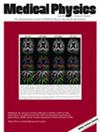Model-based perfusion reconstruction with time separation technique in cone-beam CT dynamic liver perfusion imaging
Abstract
Background
The success of embolization, a minimally invasive treatment of liver cancer, could be evaluated in the operational room with cone-beam CT by acquiring a dynamic perfusion scan to inspect the contrast agent flow.
Purpose
The reconstruction algorithm must address the issues of low temporal sampling and higher noise levels inherent in cone-beam CT systems, compared to conventional CT.
Methods
Therefore, a model-based perfusion reconstruction based on the time separation technique (TST) was applied. TST uses basis functions to model time attenuation curves. These functions are either analytical or based on prior knowledge (PK), extracted using singular value decomposition of the classical CT perfusion data of animal subjects. To explore how well the PK can model perfusion dynamics and what the potential limitations are, the dynamic cone-beam CT (CBCT) perfusion scan was simulated from a dynamic CT perfusion scan under different noise levels. The TST method was compared to static reconstruction.
Results
It was demonstrated on this simulated dynamic CBCT perfusion scan that a set consisting of only four basis functions results in perfusion maps that preserve relevant information, denoise the data, and outperform static reconstruction under higher noise levels. TST with PK would not only outperform static reconstruction but also the TST with analytical basis functions. Furthermore, it has been shown that only eight CBCT rotations, unlike previously assumed ten, are sufficient to obtain the perfusion maps comparable to the reference CT perfusion maps. This contributes to saving dose and reconstruction time. The real dynamic CBCT perfusion scan, reconstructed under the same conditions as the simulated scan, shows potential for maintaining the accuracy of the perfusion maps. By visual inspection, the embolized region was matching to that in corresponding CT perfusion maps.
Conclusions
CBCT reconstruction of perfusion scan data using the TST method has shown promising potential, outperforming static reconstructions and potentially saving dose by reducing the necessary number of acquisition sweeps. Further analysis of a larger cohort of patient data is needed to draw final conclusions regarding the expected advantages of the TST.


 求助内容:
求助内容: 应助结果提醒方式:
应助结果提醒方式:


